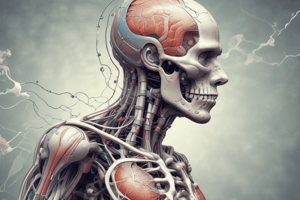Podcast
Questions and Answers
What percentage of total Ca2+ in the body is found in bone?
What percentage of total Ca2+ in the body is found in bone?
- 90%
- 75%
- 99% (correct)
- 50%
Which form constitutes the largest percentage of circulating Ca2+ in the blood?
Which form constitutes the largest percentage of circulating Ca2+ in the blood?
- Free Ca2+ ions (correct)
- Bound to proteins
- Bound to anions
- Total Ca2+ measurements
What is the primary reason why total Ca2+ cannot be reliably used to infer ionized Ca2+ levels, especially in critically ill patients?
What is the primary reason why total Ca2+ cannot be reliably used to infer ionized Ca2+ levels, especially in critically ill patients?
- All forms of Ca2+ are equivalent in terms of physiological relevance.
- Total Ca2+ measurements are less accurate than ionized measurements.
- Concentrations of various binding agents can fluctuate dramatically. (correct)
- Ionized Ca2+ is always present in equal amounts as total Ca2+.
Which of the following statements about Ca2+ distribution is true?
Which of the following statements about Ca2+ distribution is true?
How does the concentration of ionized Ca2+ in blood compare to that in the cytosol of cardiac or smooth muscle cells?
How does the concentration of ionized Ca2+ in blood compare to that in the cytosol of cardiac or smooth muscle cells?
Flashcards
Calcium Distribution in the Body
Calcium Distribution in the Body
The majority of calcium in our bodies is found in bones, with only a small percentage circulating in the blood and other fluids.
Calcium Concentration Gradient
Calcium Concentration Gradient
The concentration of ionized calcium in our blood is significantly higher than in the cells of our muscles.
Forms of Calcium in Blood
Forms of Calcium in Blood
Free calcium ions, bound to proteins like albumin, and bound to anions like bicarbonate or phosphate make up the different forms of calcium in our blood.
Factors Influencing Blood Calcium Distribution
Factors Influencing Blood Calcium Distribution
Signup and view all the flashcards
Challenges of Measuring Blood Calcium
Challenges of Measuring Blood Calcium
Signup and view all the flashcards
Study Notes
Calcium Distribution in the Body
- Approximately 99% of body calcium is in bone.
- The remaining 1% is primarily in blood and extracellular fluid (ECF).
- Cytosolic calcium is very low in most cells.
- Blood ionized calcium is significantly higher than intracellular calcium, specifically in cardiac and smooth muscle cells (by 5,000 to 10,000 times).
- This gradient is essential for rapid calcium influx.
Blood Calcium Forms
- 45% of blood calcium exists as free, ionized calcium ions.
- 40% is bound to protein, primarily albumin.
- 15% is bound to anions (HCO3-, citrate, PO4-, and lactate).
Influence of Disease States
- Calcium distribution can vary due to disease.
- Concentrations of citrate, bicarbonate, lactate, phosphate and albumin fluctuate significantly during surgical or critical care procedures.
- Therefore, total calcium measurements cannot reliably predict ionized calcium levels, particularly in critically ill patients.
Studying That Suits You
Use AI to generate personalized quizzes and flashcards to suit your learning preferences.




